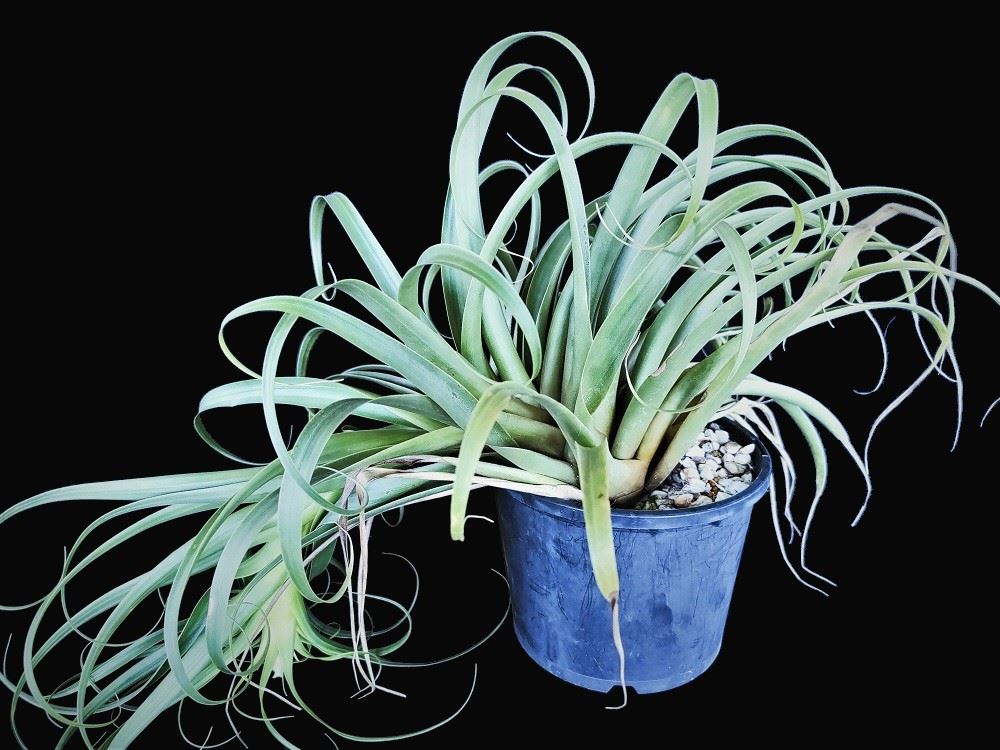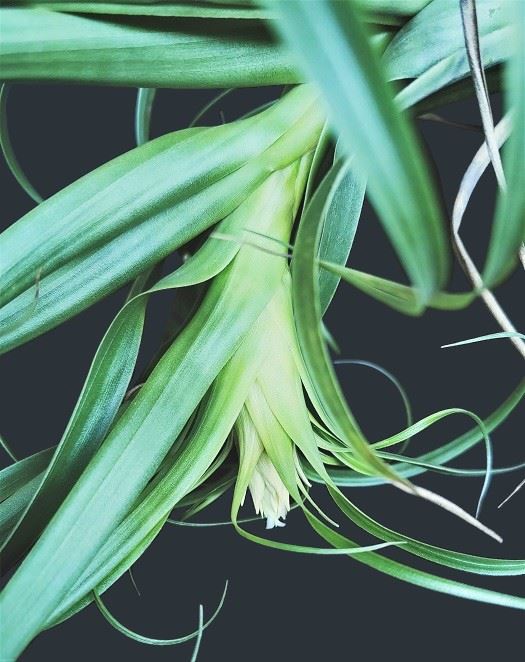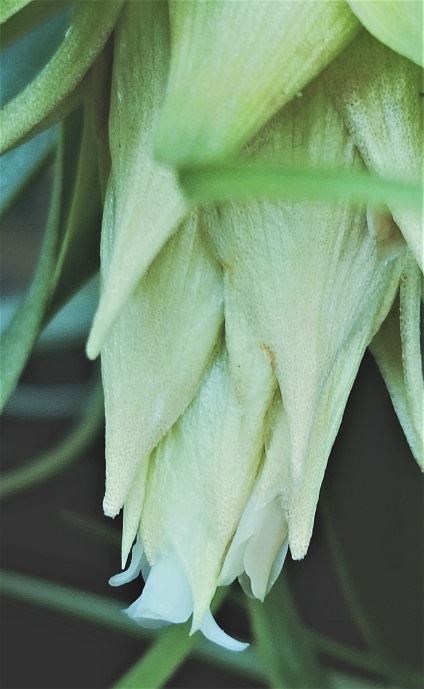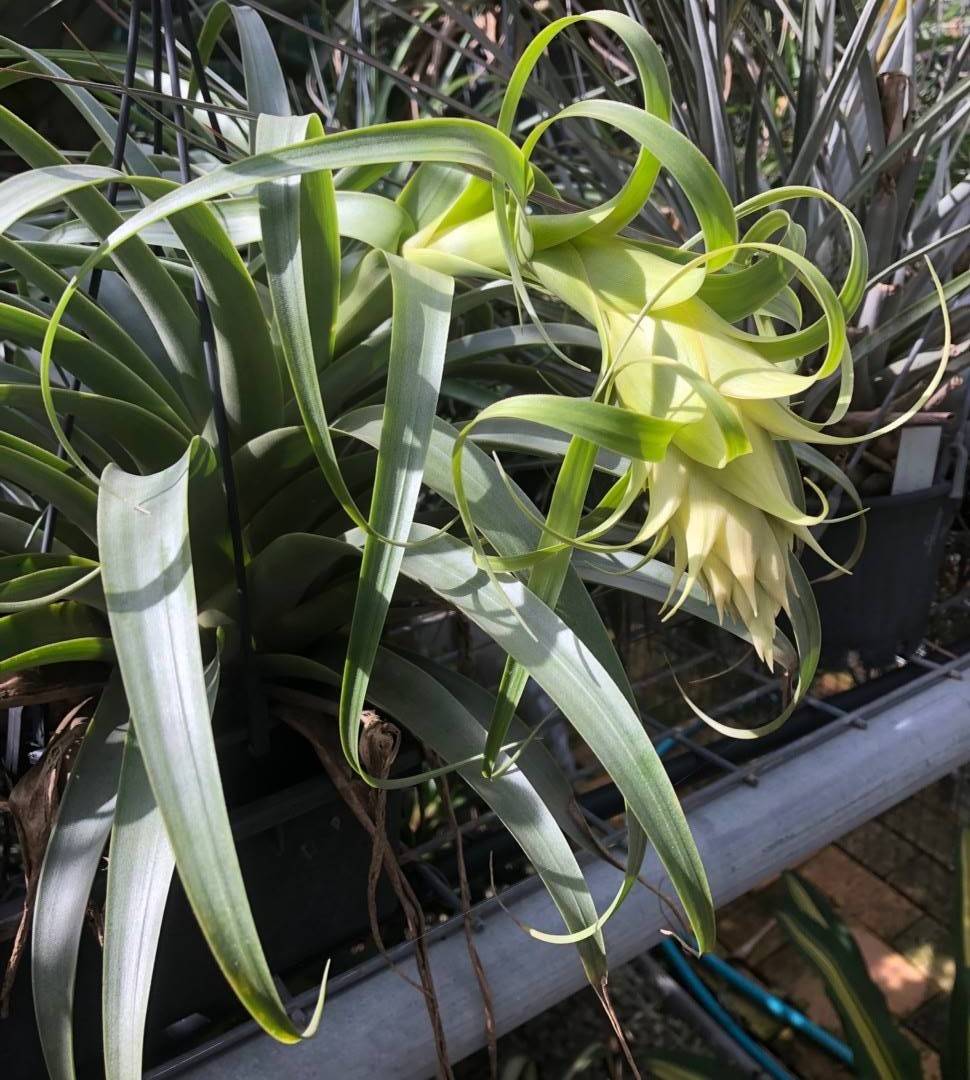





Tillandsia schreiteri Lillo & Castellanos by Ehlers & Hromradnik in Die Bromelie 2/1998 2: 36-43. 1998
Because of the merging of characteristics of T. sphaerocephala and T. schreiteri in Smith & Downs (1977) it is not possible to compare this new taxon (T. calochlamys) without looking at both taxa:
T. schreiteri is treated in Smith & Downs as a synonym of T. sphaerocephala. In the Checklist of Lloyd F. Kiff (1991), T. schreiteri is also treated as a synonym of T. sphaerocephala, but with the note, that as well as Professor W. Rauh, Dr. W. Till also considers it a good species. In the list of Luther & Sieff (1996) T. schreiteri is not even mentioned.
Only in “Bromelien” by W. Rauh (1981, 1990) are the two species separated.
What is the reason for this difficulty in differentiating them?
In the original description of T. sphaerocephala Baker, 1888, the colour of the petals shown as ‘not seen", (T. sphaerocephala flowers, as you know, violet). T. schreiteri flowers according to Lillo and Castellanos (“fide Schreiter”, white). Smith & Downs (1977) bases their description from similar Herbarium specimens in the broad sense for both types as T. sphaerocephala. Admittedly, here the holotype of T. sphaerocephala is from Sorata, Dept. La Paz, Bolivia refers apparently to the description, however, T. schreiteri from the province Tucuman, Argentina, is included in the combination. Also the illustration Fig. 240 A - B page 780, doesn't show T. sphaerocephala but is from plate 75 for T. schreiteri, after the illustration in Castellanos (1945). The white petal colour for T. schreiteri has been used for T. sphaerocephala.
Plants of T. sphaerocephala from Sorata have been cultivated in the Hromadnik's collection for many years, and never one of them has white flowers. As well - with one exception - all other collections from similar areas in Bolivia correspond with T. sphaerocephala with violet to lilac flowers. The one exception comes from the southern province of Tarija, and is just like the plants called T. schreiteri from Argentina. Besides the flower colour T. schreiteri still differs from T. sphaerocephala through its almost globular rosettes from numerous strongly bent back, thin, leaves that appear green despite the dense scales, and through lighter leaf sheaths.
Not only are the habitat areas clearly delimited from each other but also the respective heights they come from. T. sphaerocephala grows epiphytically and on rocks, in the central Bolivian highlands between 2100m and approximately 3200m, whereas T. scheiteri is found growing epiphytically, only in Argentina and in southern Bolivia below 1800 m.
Therefore, it appears to us that it is right to follow Rauh (1981, 1990) and treat T. schreiteri LILLO & CASTELLANOS, 1929, as a species in its own right.
Plant material examined:
T. schreiteri LILLO & CASTELLA¬NOS:
Bolivia, Tarija: 20 km westl. Entre Rios, 1800m, H. Hromadnik 9099 15.7.1982 (WU).
Argentina, Jujuy, Dept. Capital: a few km north. San Salvador de Jujuy on the road toTilquiza, 1350 m, on trees, W. Till 10084, 7.2.1993 (WU); Lozano, 1600m, leg. H.&L.Hromadnik 7119, 19.7.1981; Arbolito, leg. G. Trautmann s.n. 1982 (WU); Salta: El Potrerillo, 1000m, H.&L.Hromadnik 7014, 11.7.1981 (WU); Tucuman, Lules: 2 km east from Villa Nougues, 1050 m, on high trees, W. Till 10009 9.2.1993 (WU).
T. sphaerocephala BAKER:
Bolivia, Dept. La Paz: Sorata, 2700m, H.& L.Hromadnik 3124, 29.7.1977 (WU); Rio de La Paz, 3200m, H.& L.Hromadnik 3006, 15.7.1977; Dept. Cochabamba: south of. Totora, 2750m, W. Till # 4 (WU); Epizana, 2900m, Hr 3030; Comarapa, 2100m, H.& L.Hromadnik 3038, 17.7.1977 (WU); Rio Pojo, 2300m, H.&L.Hromadnik 3034, 19.2.1977 (WU); Anzaldo, Alber 1989; Kohres 1984 # 8404; Morochata, 3450m, R. Ehlers EB 951103; Morochata 3450m, L.Hromadnik 19090, 22.2.1995 (WU); Dept. Chuquisaca: Tomina, 2300m, H.& L.Hromadnik 3083, 19.2.1977 (WU); Zudanez, 2400m, H.&L.Hromadnik 5256, 30.7.1979 (WU); Rio Chico, 2000m, H.Hromadnik 13012, 7.8.1987 (WU); Rio Chico, 2550m, E.Heger 3.10.1991; km 100 from Sucre near Zudanez, E. Zecher T 55, 1972 / 73 (WU); Betanzos, 3200m, L.Hromadnik 19060, 13.2.1995 (WU).
(email) From: "Walter Till"
To: "Derek Butcher"
Subject: AW: Tillandsia sphaerocephala & schreiteri
Dear Derek,
Both species are related to each other but distinct. sphaerocephala has lilac petals while those of schreiteri are white. The latter has leaves with a more appressed indument making them shiny. I have seen schreiteri both in Tucuman and Jujuy provinces at elevations between 1050m and 1350 m respectively. This seems to be generally lower than the elevations for sphaerocephala which is found well over 2000 m.
Smith (1970) in Phytologia 20(3): 177 has placed schreiteri into synonymy of sphaerocephala without any reasoning.
Best wishes, Walter